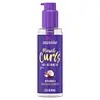What's inside
What's inside
 Key Ingredients
Key Ingredients

No key ingredients
 Benefits
Benefits

 Concerns
Concerns

 Ingredients Side-by-side
Ingredients Side-by-side

Dimethicone
EmollientIsohexadecane
EmollientC13-14 Isoparaffin
EmollientCoco-Caprylate
EmollientPhenyl Trimethicone
Skin ConditioningBis-Aminopropyl Diglycol Dimaleate
Skin ConditioningPropanediol
SolventZea Mays Oil
EmulsifyingBeta-Carotene
Skin ConditioningHelianthus Annuus Seed Oil
EmollientMoringa Oleifera Seed Oil
EmollientPunica Granatum Seed Oil
EmollientWater
Skin ConditioningMorinda Citrifolia Seed Powder
Skin ConditioningParfum
MaskingHexyl Cinnamal
PerfumingEclipta Prostrata Extract
Skin ConditioningEthylhexyl Methoxycinnamate
UV AbsorberLimonene
PerfumingTocopherol
AntioxidantCitral
PerfumingLinalool
PerfumingMelia Azadirachta Leaf Extract
Skin ConditioningCitronellol
PerfumingPseudozyma Epicola/Camellia Sinensis Seed Oil Ferment Extract Filtrate
HumectantDimethicone, Isohexadecane, C13-14 Isoparaffin, Coco-Caprylate, Phenyl Trimethicone, Bis-Aminopropyl Diglycol Dimaleate, Propanediol, Zea Mays Oil, Beta-Carotene, Helianthus Annuus Seed Oil, Moringa Oleifera Seed Oil, Punica Granatum Seed Oil, Water, Morinda Citrifolia Seed Powder, Parfum, Hexyl Cinnamal, Eclipta Prostrata Extract, Ethylhexyl Methoxycinnamate, Limonene, Tocopherol, Citral, Linalool, Melia Azadirachta Leaf Extract, Citronellol, Pseudozyma Epicola/Camellia Sinensis Seed Oil Ferment Extract Filtrate
 Reviews
Reviews

Ingredients Explained
These ingredients are found in both products.
Ingredients higher up in an ingredient list are typically present in a larger amount.
Parfum is a catch-all term for an ingredient or more that is used to give a scent to products.
Also called "fragrance", this ingredient can be a blend of hundreds of chemicals or plant oils. This means every product with "fragrance" or "parfum" in the ingredients list is a different mixture.
For instance, Habanolide is a proprietary trade name for a specific aroma chemical. When used as a fragrance ingredient in cosmetics, most aroma chemicals fall under the broad labeling category of “FRAGRANCE” or “PARFUM” according to EU and US regulations.
The term 'parfum' or 'fragrance' is not regulated in many countries. In many cases, it is up to the brand to define this term.
For instance, many brands choose to label themselves as "fragrance-free" because they are not using synthetic fragrances. However, their products may still contain ingredients such as essential oils that are considered a fragrance by INCI standards.
One example is Calendula flower extract. Calendula is an essential oil that still imparts a scent or 'fragrance'.
Depending on the blend, the ingredients in the mixture can cause allergies and sensitivities on the skin. Some ingredients that are known EU allergens include linalool and citronellol.
Parfum can also be used to mask or cover an unpleasant scent.
The bottom line is: not all fragrances/parfum/ingredients are created equally. If you are worried about fragrances, we recommend taking a closer look at an ingredient. And of course, we always recommend speaking with a professional.
Learn more about Parfum